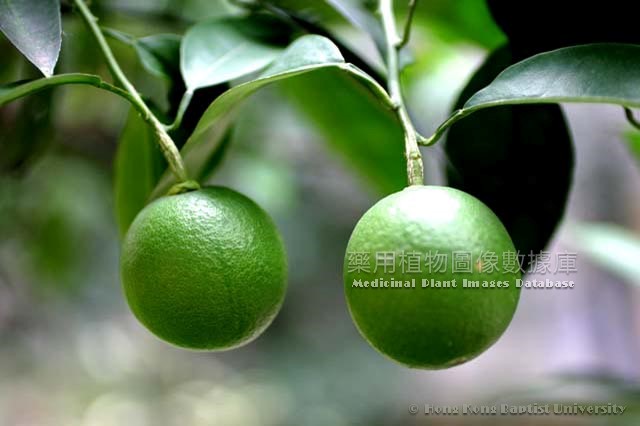|
|
|
Citrus aurantium L.

|
English Name |
Seville Orenge, Orenge, Sour Orange |
|
Latin name |
Citrus aurantium L. |
|
Family & Genus |
Rutaceae, Citrus |
|
Description |
Evergreen small trees. Stem and branches triangulate, smooth, with long spines, 5-20mm long. Leaves degenerated into single leaf-shaped, alternate; petioles with narrow-long or narrow-long inverted heart-shaped leaf wings, blades coriaceous, 8-15mm long, 3-6mm wide; blades coriaceous, oval oblong or obovate, 3.5-10cm long, 1.5-5cm wide, apex short and blunt, base cuneate or round, entire or wavy, both sides glabrous and with translucent oily dots, veins on back side prominent. Flowers solitary or few flowers clustered in leaf axils and top of very young branches, white, fragrant; calyx cup-shaped, 5 lobed; petals 5, oblong; stamens more than 20, filaments separated, out of stigma; ovary of pistil superior, stigma head-like, about 12 chambers, each chamber with numerous ovules. Hesperidiums nearly spherical and slightly flat, about 7-8cm in diameter, orange yellow when ripe; peel rough; taste sour. Flowering: April to May, fruiting: June to November. |
|
Distribution |
Growing on hilly areas or along rivers, lakes or plains. Can be cultivated. Distributed in the provinces of the south of the Yangtze River. The medicinal materials are mainly produced in Sichuan, Hunan, Jiangxi and etc. |
|
Part Used |
Medical part: fruitlets and immature fruits. Chinese name: fruitlets: Zhishi; immature fruits: Zhike. |
|
Harvest & Processing |
Zhishi: collected naturally fallen fruits from May to June, removed impurities, transected into halves in the middle, sun-dried or dried in low temperature; for small ones, directly sun-dried or dried in low temperature. Zhihe: harvested in July when pericarp is still green, transected into halves in the middle, directly sun-dried or dried in low temperature. |
|
Chemistry |
Contains volatile oils and flavonoid, such as hesperidin and neohesperidin. |
|
Pharmacology |
Anti-inflammatory for gastrointestinal tract, uterine smooth muscle, cardiovascular system, anti-bacterial, antivirotic, anti-allergic, and antioxidative. |
|
Properties & Actions |
Immature bitter orange: bitter, pungent, sour, warm. Fructus aurantii: bitter, pungent, sour, warm.Zhishi: breaking qi and dispersing accumulation, dissipating phlegm and glomus. Zhihe: regulating qi-flowing and loosening the middle, motivating stagnation and relieving flatulence. |
|
Indications & Usage |
Aurantii fructus immaturus: used for dyspeptic disease, feeling of fullness and pain, diarrhea, dysentery and tenesmus, unsmooth stools, phlegm stagnancy, choking feeling and thoracic obstruction, thoracic retention; gastroptosis, anal prolapse, prolapsus uteri. Bitter orange: used for qi stagnancy of chest and hypochondrium, fullness and pain, accumulation of food in the stomach and intestine due to indigestion, stagnancy of phlegm and diet; gastroptosis, anal prolapse, prolapsus uteri.Zhishi: oral administration: decocting, 3-10g; or made as pills or powders. External application: appropriate amount, triturated for application, or stir-heated for ironing. Use with caution in cases of pregnancies, weak body or aeipathia. Zhihe: oral administration: decocting, 5-9g; or made as pills or powders. External application: appropriate amount, decocted for washing or stir-heated for ironing. Use with caution in cases of pregnancies or deficiency in spleen and stomach. |
|
Examples |
Immature orange fruit:
After typhus, pain of chest and diaphragm: immature orange fruit, bran stir-fried grind into powder. Swallow 6g with washed water of rice, swallow 2 times a day.
Bitter orange:
Post partum mazischesis: bitter orange 60g. Remove pulp and decoct, immerse and swallow till warmed up. |
| Link to |
 Chinese Medicinal Material Images Database Chinese Medicinal Material Images Database
 Phytochemical Image Database Phytochemical Image Database
 Chinese Medicine Specimen Database Chinese Medicine Specimen Database
|
|
Permanent URL:https://sys01.lib.hkbu.edu.hk/cmed/mpid/detail.php?herb_id=D00049 |
|
|
|

